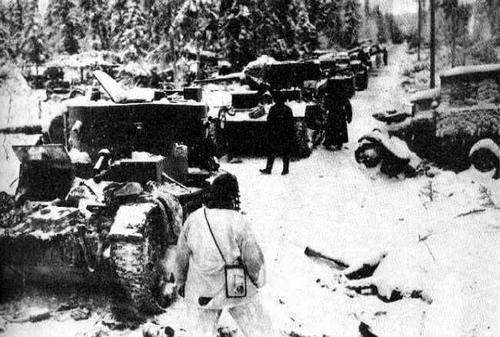Tuesday 5 December 1939
 |
| A Soviet tank column in the Finnish snow. |
On the Karelian Isthmus north of Leningrad, the Soviet 7th Army reaches the Mannerheim Line, the main series of Finnish fortifications and obstacles. There are other projected lines to the rear, but this is their best hope of stopping the Soviets. It is garrisoned by the Finnish 2nd Corps.
The Finns are proving expert at handling the Soviet tanks. They separate the tanks from their supporting infantry, then destroy them piecemeal in close combat, often at night.
Winter War Air Campaign: Finnish bombers in the far north raid the Soviet airbase in Murmansk with incendiary bombs.
Battle of the Atlantic: British cruiser Ajax intercepts the German passenger liner Ussukuma off of Uruguay. The German crew scuttles the ship. The Ajax picks up 107 survivors.
U-47 (Kapitänleutnant Günther Prien) torpedoes and sinks British merchant ship Navasota. Thirty-seven crew perish, 45 are picked up by British ships in the convoy, OB-46. Prien, of course, is the hero of the U-boat fleet after sinking the HMS Royal Oak. He is operating now south of Ireland.
The British order the US freighter Exochorda to proceed to Marseilles to unload "contraband" (tin plate). The master refuses and remains in port.
British authorities at the Downs detain the US freighter Yaka.
Battle of the Pacific: Royal Navy cruiser Despatch, on neutrality patrol off Chile, captures the German freighter Dusseldorf.
German Government: The government announces that munitions output has doubled since the start of the war and is projected to double again in six months' time.
First Lord of the Admiralty Winston Churchill goes before the House of Commons and makes a moral argument about the conduct of the war to date. He castigates the Germans for descending to "the lowest form of warfare that can be imagined." He uses as his example the use of Germans of first the gun, the torpedo, and now the mine as their primary weapons.
German/American Bund: Fritz Kuhn is sentenced to 2.5 to 5 years for larceny and forgery.
China: The Japanese continue their spoiling attacks against the Chinese winter offensive around Wenhsi and Hsia Hsien.
At the Battle of South Kwangsi, the Japanese realize they are simply chasing the Chinese into the endless hills without any purpose. They stop and dig in just north of Nanning.
December 1939
December 1, 1939: Finland Fights for its LifeDecember 2, 1939: First RAF Bombs on Germany
December 3, 1939: Soviets Still Advancing in Finland
December 4, 1939: Molotov to Roosevelt - Mind Your Own Business
December 5, 1939: Prien Returns
December 6, 1939: Attacks on Mannerheim Line
December 7, 1939: Kollaa Holds!
December 8, 1939: Polish Pilots Return
December 9, 1939: First British BEF Fatality
December 10, 1939: The Soviets Capture Salla in Finland
December 11, 1939: Finns Make Their Move
December 12, 1939: Finnish Success in the Winter War
December 13, 1939: Battle of River Platte December 14, 1939: Quisling Meets Hitler
December 15, 1939: Chinese Winter Offensive in High Gear
December 16, 1939: Battle of Summa
December 17, 1939: End of Admiral Graf Spee
December 18, 1939: Battle of Heligoland Bight
December 19, 1939: British Disarm Magnetic Mines
December 20, 1939: Finnish Counterattacks Continue
December 21, 1939: Finns Plan More Counterattacks
December 22, 1939: Enter Chuikov
December 23, 1939: Failed Finnish Counterattack
December 24, 1939: Soviets on the Run
December 25, 1939: Fresh Soviet Attacks
December 26, 1939: Vicious Battles at Kelja
December 27, 1939: Grinding Finnish Victories
December 28, 1939: Liberators
December 29, 1939: Finns Tighten the Noose
December 30, 1939: Finnish Booty
December 31, 1939: Planning More Soviet Destruction
2019




